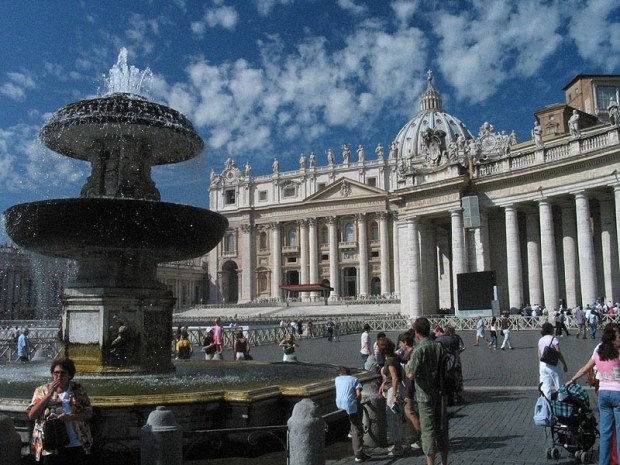When walking around St. Peter's Square, it is hard to take one’s eyes off the breathtaking sight of the basilica’s iconic dome towering behind the square’s Egyptian obelisk. But the most famous square in the world wouldn't be the same without the two majestic fountains that give it a harmonious sense of symmetry captured by photographers from around the world.
The two fountains, standing on opposite sides of the obelisk, were the work of Baroque masters Carlo Moderno and Gian Lorenzo Bernini. Ancient Romans used to build fountains as a way to celebrate rulers and decorate public places, a tradition extended by the Catholic Church.

The fountain on the right side of the obelisk was built first. It was commissioned by Pope Paul V Borghese in 1612 and completed in 1614. Pope Paul V famously oversaw the restoration of one of Rome’s most important aqueducts, the aqueduct of Trajan, and created in its final part a “master fountain” called Acqua Paola, designed to provide water to the part of Rome located on the right bank of the Tiber River.
The water coming from this “master fountain,” located at 741 feet above sea level on top of the Janiculum hill, could provide water to fountains and public baths situated at lower elevations through a system of underground water tunnels. This ensured enough water supply for the new fountain project in Vatican square.
In 1612, Paul V hired Baroque architect Carlo Maderno, famous for completing some of the designs of St. Peter’s facade, to create the structure over a previously existing fountain. Maderno built an octagonal base and placed a large irregular basin on top with steps and columns to prevent water from overflowing. An ornamental pedestal with four stone scrolls was placed on top of the old Roman basin and topped with a smaller basin covered with stone scales.
This "mushroom-like” structure allows water to descend from the top of the fountain and, when touching the top of the higher vase, to be broken off and sparkle through the stone scales.

On the left side of the square stands the fountain built by famed Baroque architect Gian Lorenzo Bernini, the artist behind the stunning gilt-bronze baldachin of St. Peter’s Basilica. Bernini was asked to create a second fountain in 1667, 50 years after the Maderno fountain was built, by Pope Clement X. It took 10 years to build the second fountain, which was shaped as an exact replica of Maderno’s creation. This way, the most famous square in the world now had “twin” fountains flanking the obelisk and the entrance to the basilica.

Both fountains were operated without the use of pumps, thanks to gravity and a system of pressure valves.
The two fountains of St. Peter's Square have inspired architects across Europe, including Jacques-Ignace Hittorff, the architect who created the “Fontaines de la Concorde” in Paris’ Place de la Concorde and some of the fountains of Peterhof, commissioned by Peter the Great in St. Petersburg.
Today, the twin fountains, which have operated continuously since their construction in the 17th century save for a brief hiatus during a severe drought in 2017, are among the most photographed landmarks in Rome.



